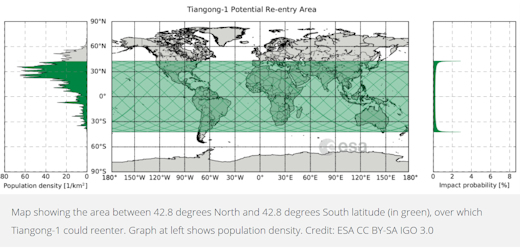China’s Tiangong-1 space station is about to return to Earth–as a massive fireball.
According to the European Space Agency (ESA), the 8-ton spacecraft will re-enter the atmosphere sometime between March 30th and April 2nd. Tiangong-1 is about the size of a European cargo spacecraft, such as the ATV-1 which itself re-entered in 2008. This re-entry video of the ATV-1 shows what the Tiangong-1 fireball might look like.
Tiangong-1 was launched in Sept. 2011 to establish a foothold in Earth orbit for China’s fledgling space program. It served as a temporary home in space for two crews, including China’s first female astronauts, and provided a testbed for automated rendezvous and docking procedures. China lost control of Tiangong-1 in 2016 when a telemetry link failed. This made it impossible for mission controllers to guide the station to a re-entry over the South Pacific Ocean as originally planned. Instead, Tiangong-1 would re-enter on its own schedule as aerodynamic friction with Earth’s upper atmosphere slowly drained the station’s orbital energy.
Initially, Chinese officials speculated that re-entry would occur in late 2017. However, low solar activity delayed the splashdown. Sunspot numbers have plummeted recently as the solar cycle heads toward a deep solar minimum:
Without sunspots, the sun’s extreme ultraviolet radiation decreased. Earth’s upper atmosphere cooled and contracted, reducing aerodynamic friction that would otherwise bring Tiangong-1 down. “Late 2017” became the spring of 2018.
At the moment it is impossible to predict exactly where Tiangong-1 will re-enter. All we know is that it will disintegrate somewhere between +42.8 and -42.8 degrees latitude, the upper and lower limits of the station’s tilted orbit. This map from the ESA shows the re-entry zone:
Even with an uncontrolled re-entry, the odds strongly favor a descent over uninhabited land or ocean. According to the ESA, “[surviving fragments] will be scattered over a curved ellipsoid that is thousands of km in length and tens of km wide. The personal probability of being hit by a piece of debris from the Tiangong-1 is actually 10 million times smaller than the yearly chance of being hit by lightning.”
In other words, don’t worry. You’ll be lucky just to see the fireball. Approximately one day before the reentry, it will become possible to roughly predict re-entry ground tracks, and hence which regions on Earth might witness the disintegration.
Source: Spaceweather.com


































Leave a Comment
You must be logged in to post a comment.